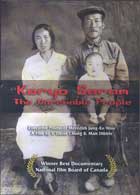
Koryo Saram: The Unreliable People 2013
Distributed by Microcinema International/Microcinema DVD, 71 Stevenson St. Suite 400, San Francisco, CA 94105; 415-447-9750
Produced by Meredith Jung-En Woo
Directed by Y. David Chung and Matt Dibble
DVD , color and b&w
Sr. High - General Adult
Discrimination, Immigration, Geography, Globalization, History, Human Rights, Soviet History, War, World War II
Date Entered: 11/15/2013
Reviewed by Jason R. Harshman, The Ohio State UniversityFrom 1910 through the onset of the Cold War, Koreans living in Far Eastern Russia and later Central Asia suffered greatly under, but also survived as a form of resistance against, the rule of Japan and Josef Stalin. In 1937, more then 180,000 Koreans were transported 4,000 miles from the Pacific coast of Russia to Uzbekistan and Kazakhstan. In tightly packed “Ghost Trains” that stopped only to discard deceased men, women, and children en route to these Soviet Republics, Koreans were subjected to physical, cultural, and psychological trauma as part of Stalin’s purges. Through first hand experiences and archival footage, this documentary brings forth voices from central Asia that were ignored for decades. Koryo Saram—translated as the “unreliable people” under Stalin, but also means “Korean Person” in a Korean dialect that is no longer used—illustrates how the hardships faced by so many under Josef Stalin during the 1930s and 40s was not limited to Russians and Eastern Europeans, as is often the narrative, but Koreans who had been living in areas considered to be the Asian regions of the Soviet Union.
The first part of the film provides an overview of how the Korean peninsula was occupied by Japan at the start of the twentieth century and then Japan’s expansion across East Asia during the 1930s until the outbreak of WWII. Viewers learn that the first Koreans to emigrate to Russia did so in 1863. Records kept by Russian border guards reveal that 13 families moved from Korea to far eastern Russia to settle long before the Russo-Japanese War in 1905 and the annexation of Korea in 1910 permanently disrupted the lives of Koreans throughout the peninsula.
The majority of the film includes excerpts from interviews used as voiceovers for photographs, video footage, and contemporary representations of what life was and is like for people of Korean decent living in Central Asia. The communities that grew out of the forced relocation of Koreans under Stalin maintain Korean cultural practices even if many speak Russian. The documentary does an effective job of bringing forth the continued identity struggles that survivors contend with as they simultaneously look to maintain Korean cultural practices, but also recognize that over time they have adopted—by force and by choice—Uzbek, Russian, and Kazakh cultural practices. This documentary is an important contribution to studies of human rights, diaspora, and marginalized voices in history and brings forth new perspectives on how Koreans were affected by and continue to grapple with the ramifications of Japanese Empire and Stalin’s totalitarian rule during the twentieth century.